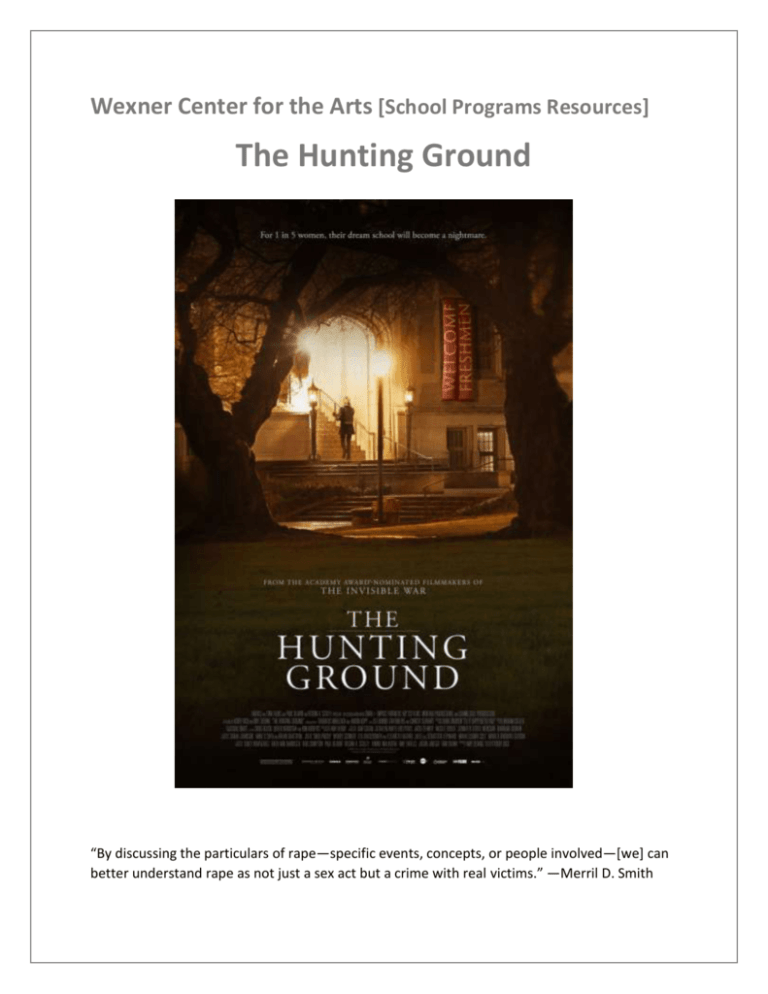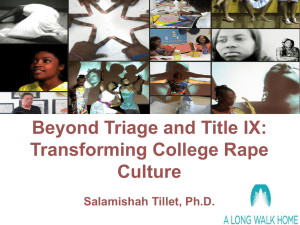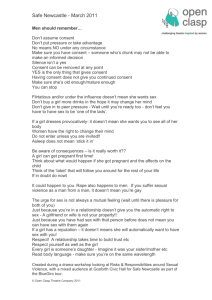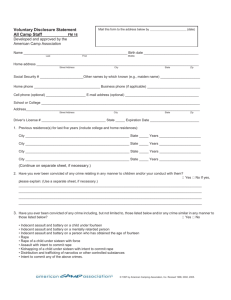Worldview Resources_The Hunting Ground
advertisement

Wexner Center for the Arts [School Programs Resources] The Hunting Ground “By discussing the particulars of rape—specific events, concepts, or people involved—[we] can better understand rape as not just a sex act but a crime with real victims.” —Merril D. Smith About the Film Synopsis: From the makers of The Invisible War (2012) comes a startling exposé of rape crimes on U.S. college campuses, their institutional cover-ups and the devastating toll they take on students and their families. Weaving together verité footage and first-person testimonies, the film follows the lives of several undergraduate assault survivors as they attempt to pursue despite incredible push back, harassment, and traumatic aftermath - both their education and justice. (Source: imdb.com) Official Website: http://www.thehuntinggroundfilm.com/ A viewing guide for the hunting ground film provided by the Clery Center for safe campuses. Related Websites End Rape on Campus is a national organization providing confidential, complimentary resources to survivors, parents, alumni, and faculty seeking support. RAINN (Rape, Abuse & Incest National Network) is the nation's largest anti-sexual violence organization. RAINN created and operates the National Sexual Assault Hotline (800.656.HOPE and online.rainn.org) in partnership with more than 1,100 local rape crisis centers across the country and operates the DoD Safe Helpline for the Department of Defense. RAINN also carries out programs to prevent sexual violence, help victims and ensure that rapists are brought to justice. 1in6: The mission of 1in6 is to help men who have had unwanted or abusive sexual experiences in childhood live healthier, happier lives. Our mission also includes serving family members, friends, and partners by providing information and support resources on the web and in the community. The United Nations website provides information about the worldwide statistics and information about sexual violence against women across the world. Sexual Violence Research Initiative: In 2003, recognizing the need for more research on sexual violence, especially in resource poor settings, the Global Forum for Health Research established the Sexual Violence Research Initiative (SVRI). The SVRI is a global research initiative that aims to promote good quality research in the area of sexual violence, particularly in developing countries. We are building an experienced and committed network of researchers, policy makers, activists and donors to ensure that the many aspects of sexual violence are addressed from the perspective of different disciplines and cultures. Know Your IX: Founded in 2013, Know Your IX is a national survivor-run, student-driven campaign to end campus sexual violence. Running on grassroots energy, we educate students across the country about their civil right to education free from sexual violence and harassment while also pushing policy and legislative change on the national level for better federal enforcement of that same right. Know Your IX fills the gap between the law on the books and survivors on the ground: we work to educate our fellow students about their rights and empower them to take action for safety and equality on campus; and bring students’ voices, experiences, and concerns to policymakers writing the next chapter in Title IX’s history. Articles and Blogs Individual state laws and statistics on teen dating violence available on the national conference of state legislatures’ website. An interesting article on newrepublic.com that talks about the importance of teaching teens about consent. Project Unbreakable is a photography project aiming to give a voice to survivors of sexual assault, domestic violence, and child abuse. Project Unbreakable has been featured in media outlets such as Glamour, TIME, Buzzfeed, and The Guardian. Survivors to Thrivers is a blog about overcoming sexual abuse and the journey from victim to survivor to thriver. Survivor Love Letters: There are many misconceptions about what it’s like to be a sexual assault survivor. One particularly harmful assumption is that survivors are affected by their experience only in the immediate wake of trauma. Every survivor’s experience is different, but many will agree that healing is an ongoing process. Media justice organizer and filmmaker Tani Ikeda is addressing this reality with her powerful new project, Survivor Love Letter. Lesson Plans and Activities Discovery education features a lesson plan for Grades 9-12 for helping students understand and discuss what counts as sexual harassment. The lesson plan details the objectives, procedures of the activity, discussion questions, and suggested reading. The Consensual Project partners with schools and universities to bring students a fresh understanding of consent. The innovative curriculum, workshops, and website empower young people to incorporate consent into their daily lives. The Consensual Project is committed to helping students connect through consent. An article on genprogress.org that talks about how to discuss campus sexual assault with high school students. Film/Video It Was Rape U.S. sexual assault statistics are startling—and have remained unchanged for decades. The latest White House Council on Women and Girls report reveals that nearly one in five women experiences rape or attempted rape in her lifetime. IT WAS RAPE gives human faces and voices to statistics, breaking through the silence, denial and victim blaming that allow an epidemic to thrive. Eight women of different backgrounds, ages and ethnicities relate personal stories of surviving sexual assault in their younger years, as well as their struggles toward healing, empowerment, and finally speaking out. By award-winning feminist author, filmmaker and activist Jennifer Baumgardner, this strikingly relevant documentary will engage all audiences in needed dialogue about the prevalence of sexual assaults in the U.S., at our schools and colleges, and the elements promoting rape culture on and off campus. This film is a crucial resource for colleges and communities to meaningfully address Title IX issues around sexual violence. Searching for Angela Shelton In the uplifting and multiple award-winning documentary, Searching for Angela Shelton, filmmaker Angela Shelton drives around the United States surveying other Angela Sheltons. She discovers that 70% of the Angela Sheltons she speaks to are survivors of rape, childhood sexual abuse and/or domestic violence. India’s Daughter India’s Daughter is the powerful story of the 2012, brutal gang rape on a Delhi bus of a 23 year old medical student, who later died from her injuries. In 2012, it made international headlines and ignited protests by women in India and around the world. This month India’s government banned the film while the BBC moved their planned broadcast up by days and ignited a new controversy. BAFTA winning filmmaker Leslee Udwin, herself a victim of rape, went to India inspired by the protests against sexual assault. With an all Indian crew, Udwin got exclusive, first time on camera interviews with the rapists and defense attorney, none of whom express remorse. The defense attorney goes even further, stating that “immodest” women deserve what happens to them. An impassioned plea for change, INDIA’S DAUGHTER pays tribute to a remarkable and inspiring young woman and explores the compelling human stories behind the incident and the political ramifications throughout India. But beyond India, the film lays bare the way in which societies and their patriarchal values have spawned such acts of violence globally. Recommended Books Unipinned A story of courage and triumph, offering hope for every man and woman who have suffered sexual assault and abuse. In Unpinned, Grant Watkins tells unflinchingly of the horrors he went through and the courageous journey he took to unleash his own unique and resilient spirit. The prevailing beliefs that sexual assault does not happen to men are challenged. Readers are offered hope as they learn the lessons of recovery with Grant as he revisits the ghosts of the past that nearly destroyed him. After being sexually assaulted, part of Grant shut down and his spirit was broken. Grant knew that in order for him to get over his fear, He would have to face it. Although Grant's recovery process took place over a period of years, this book recounts his four-day journey to his childhood home, where he confronted his past and the man who raped him. The memories that were triggered along the journey helped Grant understand how his experiences growing up affected his self-esteem and his ability to recover from the rape. Yes Means Yes In this groundbreaking new look at rape edited by writer and activist Jaclyn Freidman and Full Frontal Feminism and He’s A Stud, She’s A Slut author Jessica Valenti, the way we view rape in our culture is finally dismantled and replaced with a genuine understanding and respect for female sexual pleasure. Feminist, political, and activist writers alike will present their ideas for a paradigm shift from the “No Means No” model—an approach that while necessary for where we were in 1974, needs an overhaul today. Representing Rape Representing Rape is the first feminist analysis of the language of sexual assault trials from the perspective of linguists. Susan Ehrlich argues that language is central to all legal settings - specifically sexual harassment and acquaintance rape hearings where linguistic descriptions of the events are often the only type of evidence available. Language does not simply reflect but helps to construct the character of the people and events under investigation. TED Talks Sexual Assault on College Campuses, Natalie Spiert https://youtu.be/QK1Hm94CqzU Terminology Rape is a form of sexual assault, but not all sexual assault is rape. The term rape is often used as a legal definition to specifically include sexual penetration without consent. For its Uniform Crime Reports, the FBI defines rape as “penetration, no matter how slight, of the vagina or anus with any body part or object, or oral penetration by a sex organ of another person, without the consent of the victim.” (source: Rainn.org) o STATISTICS on Rape, Sexual Assault, Consent http://www.washingtonpost.com/graphics/local/sexual-assault-poll/ Force doesn’t always refer to physical pressure. Perpetrators may use emotional coercion, psychological force, or manipulation to coerce a victim into non-consensual sex. Some perpetrators will use threats to force a victim to comply, such as threatening to hurt the victim or their family or other intimidation tactics. (source: Rainn.org) Title IX: Title IX is a landmark federal civil right that prohibits sex discrimination in education. It is a prohibition against sex-based discrimination in education. It addresses discrimination against pregnant and parenting students and women. It also addresses sexual harassment, gender-based discrimination, and sexual violence. Sexual violence includes attempted or completed rape or sexual assault, as well as sexual harassment, stalking, voyeurism, exhibitionism, verbal or physical sexuality-based threats or abuse, and intimate partner violence.(source: knowyourix.org) Consent: Consent is an issue that constitutes the very essence of rape prosecutions…Consent means to agree to or approve of what is done or proposed, or to give one’s permission. The law recognizes two kinds of consent. An express consent is one that is directly given, either verbally or in writing, and clearly demonstrates an accession of the will of the individual giving it. An implied consent is indirectly given and is usually indicated by a sign, an action or inaction, or a silence that creates a reasonable presumption that an acquiescence of the will has been given…an individual must be mentally and physically capable of granting consent…It is vital that the consent that is uninformed, has been given in ignorance, or has been obtained through force, fraud, coercion, or duress. (source: Encyclopedia of Rape) o CONSENT http://www.nytimes.com/2015/08/02/education/edlife/affirmative-consent-are-students-reallyasking.html?_r=0 http://www.theatlantic.com/politics/archive/2014/10/why-a-college-student-abandonedaffirmative-consent/381650/ http://www.elle.com/culture/career-politics/a27690/10-women-on-what-hooking-up-and-consentis-like-at-college/ http://www.elle.com/life-love/sex-relationships/news/a23273/suny-consent-policy/ http://www.elle.com/culture/news/a26488/tessa-hill-lia-valente-peitition-consent-sex-education/ Discussion Questions Though the majority of sexual assault victims are women, men are also victims. RAINN recently had several members of its Speakers Bureau on The Oprah Show discussing male sexual assault and abuse. How else can this be message be disseminated? Should it be a priority message? How can we make men more comfortable speaking out about their experiences with sexual violence? (source: Rainn.org) Regardless of the fictional nature of certain storylines, portrayals of sexual violence are seen on television and in movies, and may trigger strong memories/emotions for those who have been sexually assaulted. Is this a problem? Do you believe it’s beneficial to discuss these issues in pop culture outlets such as TV shows and movies? What are the effects of these images? Are these portrayals so didactic that they can act as a "how to," or are they so horrific that they actually act as a deterrent? Where is the line? (source: Rainn.org) Artists Engaging Through Their Work Rape, Sexual Assault, and Violence Alketa Xhafa-Mripa’s exhibition, Thinking of You, commemorates the tens of thousands of Albanians who experienced sexual violence during the 1998-99 Kosovo war against Serbia Yan Yinhong created a performance piece, One Person’s Battlefield, that spoke out against the use of rape as a tactic of police domination in China; in one recent performance of the piece, she was actually sexually assaulted during the presentation of the work by two male artists Marina Abramovic’s 1974 performance, Rhythm 0, allowed members of the audience to take any action they wished to upon her standing body from 8 am to 2 pm. She discusses the piece in this brief video, which also includes documentary photos of the performance: https://vimeo.com/71952791 Valie Export’s 1969 performance, Action Pants: Genital Panic. Though it’s not directly about sexual consent, it does address the issue of how a woman presenting her own body in a nonpatriarchal way may be perceived as a threat and could be connected to a broader idea that rape and sexual assault often happen when perpetrators believe they hold more claim over the survivor’s body than the survivor does. Yoko Ono & John Lennon collaborated on the 1969 film, Rape, which features a cameraman chasing a young woman through the streets until knocking her down in a symbolic rape Project Unbreakable (a tumblr project in which people offer their written testimonials through photos) http://projectunbreakable.tumblr.com/ Nan Goldin, The Ballad of Sexual Dependency, features a photo of her after having been beaten by her partner (not sure if you want to broaden the rape/sexual assault scope to include intimate partner violence) Blank Noise, a collective in India has staged public artworks inviting strangers to talk about anything but sexual violence, as a means of highlighting its omnipresence and unspeakability in public spaces. Force: Upsetting rape culture is a Baltimore-based group that uses art actions, such as online campaigns to insert consent-positive messages on Victoria’s Secret clothes or physical creation of rape quilts (like the AIDS quilt). Arte Sana (Art Heals) is an international organization in the Americas that offers aid to victims of gender-based violence. One of the art projects that they encourage is the creation of altars for the Days of the Dead to commemorate losses THEATER & TEXT Robbie McCauley created the play, Sally’s Rape (1991), which examines the interconnectedness of racism, slavery, and sexual violence in the US. We have a copy on DVD in Thompson library. I’ve attached an article that discusses the play to this e-mail. Excerpts from The Vagina Monologues Brief poem from Mariah Conn, a college student http://www.thefeministwire.com/2015/06/college-feminisms-everyday-athlete/ Good Kids o Here is a good review of the play: http://www.americantheatre.org/2014/10/01/naomiiizukas-good-kids-tackles-sexual-assault-at-universities/ as well as another one from Mlive that reviews the production at the University of Michigan: http://www.mlive.com/entertainment/annarbor/index.ssf/2014/10/theater_review_naomi_iizukas_g_1.html. o Another critic of the play (whom I believe is a college student) takes a dimmer view of the work’s lack of character development, attention to intersectionality, and respect for the trauma experienced by survivors: http://www.michigandaily.com/blog/podium/maris-harmon-good-kids-good-enough. o The University of Michigan site includes a trailer for the play that gives of a sense of the production: http://music.umich.edu/goodkids/the_gallery.html, as well as a behind-thescenes video: https://www.youtube.com/watch?t=27&v=0hbIUofGZyM o The University of Iowa has a 46-minute documentary about the making of Good Kids: https://vimeo.com/120761452 and The Daily Iowan offers a slideshow of photos from the production, which gives you a good sense of the staging: http://www.dailyiowan.com/slideshow/0205goodkids/ ESSAYS 2013 essay about Anti-Rape underwear and how the existence of this product perpetuates victim-blaming http://yfa.awid.org/2013/11/why-selling-anti-rape-wear-perpetuates-victimblaming/ along with the original product video for Anti-Rape Underwear Other Resources Activism https://cultureofrespect.org/ Provides a wealth of resources for research, activism, and personal use. This is a great clearinghouse site. o Young Feminist Wire www.yfa.awid.org Art and Healing Social worker, advocate, activist, and artist, Natalie Spiert, on art and healing https://vimeo.com/63867024





